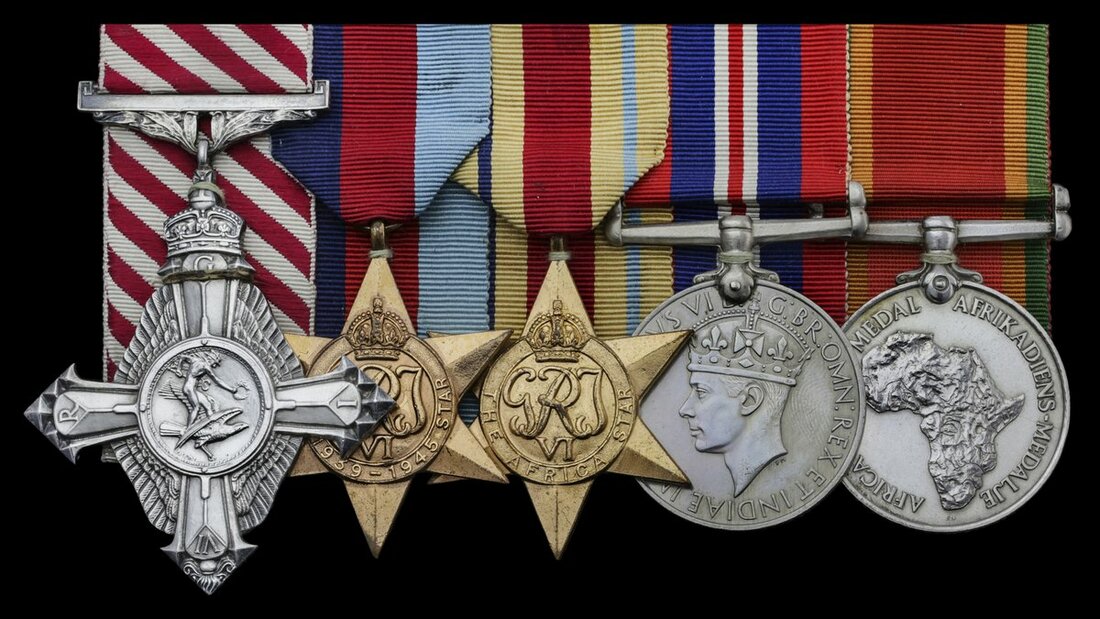Auction: 20003 - Orders, Decorations and Medals
Lot: 306
A Second World War 'VIP flight' A.F.C. group of five awarded to Captain R. W. H. 'Ronnie' Simpson, South African Air Force, who flew Hurricanes with No. 1 Squadron - bagging a Ju87 in a hair-raising scrap over Tobruk in 1941 - before notching up nearly 4,000 hours flying Shuttle Duties and ending the War as Personal Lodestar Pilot to Prime Minister Smuts
Air Force Cross, G.VI.R., reverse dated '1946'; 1939-45 Star; Africa Star; War Medal 1939-45; Africa Service Medal 1939-45, last four all officially impressed '203016 R. W. H. Simpson.', good very fine (5)
A.F.C. London Gazette13 June 1946. The original recommendation states:
'An experienced flying instructor at the outbreak of war, this Officer, although 38 years old, took part in operations and he did a magnificent job in the Shuttle Service on Lodestars and Dakotas and attained a sufficiently high standard to be appointed personal Lodestar pilot to the Prime Minister in February 1945. A measure of his hard work is indicated by his present grand total of 3,800 hours flying, the greater percentage of which was logged on S.A.A.F. Shuttle duties, and although his total flying for the part six months is only 65 hours, this was unavoidable as his duties were dictated by the Prime Minister's needs. He really is a hardworking and deserving pilot.'
Ronald Walter Harold Simpson was born on 18 July 1907 and was an electrician upon his enlistement in July 1937. Noted as having previously served as a Private in the Natal Carbineers, he joined the Air Training Squadron and assumed duty with No. 1 (Fighter) Squadron, South African Air Force on 15 June 1940 in Egypt. Simpson's role in an engagement over Tobruk on 30 June 1941 is recalled by Captain V. Voss in The Story of No. 1 Squadron S.A.A.F. (Sometimes known as the Billy Boys):
'The three pilots who took off at 1240hrs, were Captain 'Bennie' Osler, Lt. Ronnie Simpson and Lt. A. S. Russell. They were patrolling from south to north at respectively 8,000, 10,000 and 15,000 feet when Lt Russell sighted 8 Ju87s approaching from the south in a wide vic, with 8 Me109s as escort above them. He warned the other two over the R/T and at the same time the Stukas went into line astern and dived on the ships. Both Capt. Osler and Lt. Simpson attacked the Stukas, each of them putting a rear-gunner out of action, and shortly afterwards the two Ju87s crashed into the sea.
When Ronnie Simpson attacked the first Ju87 he was so close to it that he nearly rammed it. As he was firing at a second Ju87 he was attacked by a Me109 and he had to break away. After some quick manoeuvering he was about to deliver a frontal attack, from below, on the 109, when his guns jammed. and he had to run for Sidi Barrani. As he left the ships he found two Me109s above his tail, and two more below on the starboard side. To increase his speed he pulled the tit, and although the E/A were still gaining on him they turned back to rejoin the Stukas.'
During that engagement Osler was shot through the oil tank whilst Russell was killed.
Simpson served with No. 1 Squadron in Egypt until 28 February 1942 and thence took up work instructing future Pilots before working on Shuttle Duties. He was appointed as personal Lodestar Pilot to Prime Minister Smuts in February 1945, whence he flew the silver Lodestar 234. It had been an ex-South African Airways aeroplane which retained its natural metal finish when it became No. 234 of the South African Air Force. He was succeded by Lieutenant-Colonel McKay in this role in October 1945, earning his A.F.C. in the process. No. 234 was returned to South African Airways on 19 August 1946. Simpson took up work with the Irrigation Department at Andalusia after the War and was working there in 1947 when invited to his investiture at Pretoria in November that year; sold with copied service record and research.
Subject to 20% VAT on Buyer’s Premium. For more information please view Terms and Conditions for Buyers.
Sold for
£1,500
Starting price
£750







